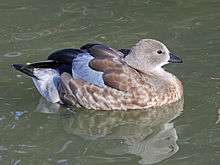Blue-winged goose
| Blue-winged goose | |
|---|---|
 | |
| At Sylvan Heights Waterfowl Park | |
| Scientific classification | |
| Kingdom: | Animalia |
| Phylum: | Chordata |
| Class: | Aves |
| Order: | Anseriformes |
| Family: | Anatidae |
| Genus: | Cyanochen Bonaparte, 1856 |
| Species: | C. cyanoptera |
| Binomial name | |
| Cyanochen cyanoptera (Rüppell, 1845) | |
| Synonyms | |
|
Cyanochen cyanopterus (Rüppell, 1845) | |
The blue-winged goose (Cyanochen cyanoptera) is a waterfowl species which is endemic to Ethiopia. It is the only member of the genus Cyanochen.
Relations


The relations of this species among the waterfowl is unresolved. It is morphologically close to shelducks, and particularly the South American sheldgeese, which have highly similar courtship displays.[2] However, mitochondrial DNA sequence analyses of the cytochrome b and NADH dehydrogenase subunit 2 genes indicates that it might belong to a very distinct and ancient "duck" clade, together with Hartlaub's duck, another African species of uncertain affinities.[3] The wing color pattern, a good morphological indicator of evolutionary relationships in waterfowl, is similar in these two species, and very different from any other waterfowl.[3][4]
Description
This is a stocky grey-brown bird about 70 centimetres (28 in) long with a slightly paler head and upper neck. It has a small black bill and black legs. In flight, this species shows a pale blue forewing. Sexes are similar, but immature birds are duller. The plumage of these birds is thick and loose, furlike as an adaptation to the cold of the Ethiopian highlands.[2]
Voice
The blue-winged goose is a quiet species, but both sexes may give a soft whistle; it does not honk or cackle like the true geese.
Habitat
The habitats of the blue-winged goose are primarily rivers, freshwater lakes, swamps, freshwater marshes, water storage areas, and subtropical or tropical high-altitude shrubland or grassland.
Behaviour
It feeds by grazing, and is apparently largely nocturnal, loafing during the day. It can swim and fly well, but this terrestrial bird is reluctant to do either, and is quite approachable. It forms flocks outside the breeding season.
It breeds by mountain lakes and streams. This little-known species is believed to build a lined nest amongst grass tussocks, and to lay 6–7 eggs.
Status
It is threatened by habitat loss, trapping for food and possibly drought. Formerly classified as a Near Threatened species on the IUCN Red List, new research has shown it to be rarer than it was believed. Consequently, it is uplisted to Vulnerable status in 2008.[5][6]
References
- ↑ BirdLife International (2012). "Cyanochen cyanoptera". IUCN Red List of Threatened Species. Version 2013.2. International Union for Conservation of Nature. Retrieved 26 November 2013.
- 1 2 Kingdon, J. (1989). Island Africa: The Evolution of Africa's Rare Plants and Animals. Princeton: Princeton University Press. ISBN 0-691-08560-9.
- 1 2 Johnson, Kevin P.; Sorenson, Michael D. (1999). "Phylogeny and biogeography of dabbling ducks (genus Anas): a comparison of molecular and morphological evidence" (PDF). Auk. 116 (3): 792–805. doi:10.2307/4089339. Retrieved 1 January 2009.
- ↑ Madge, Steve; Burn, Hilary (1987). Wildfowl: an Identification Guide to the Ducks, Geese and Swans of the World. London: Christopher Helm. ISBN 0-7470-2201-1.
- ↑ BirdLife International (2008). "Cyanochen cyanoptera". IUCN Red List of Threatened Species. Version 2008. International Union for Conservation of Nature. Retrieved 5 November 2009.
- ↑ BirdLife International (2008). "2008 IUCN Redlist status changes" (Excel Spreadsheet). Retrieved 23 May 2008.
External links
| Wikimedia Commons has media related to Cyanochen cyanoptera. |
